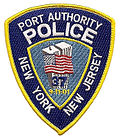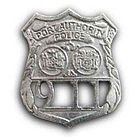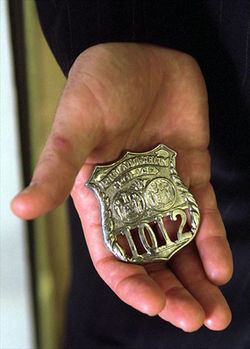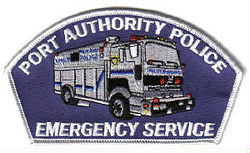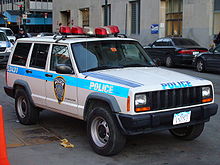- Port Authority of New York and New Jersey Police Department
-
Port Authority of New York and New Jersey Police Department Common name Port Authority Police Department Abbreviation PAPD Patch of the Port Authority of New York and New Jersey Police Department. Shield of the Port Authority of New York and New Jersey Police Department Motto Pride - Service - Distinction Agency overview Formed 1928 Legal personality Governmental: Government agency Jurisdictional structure Operations jurisdiction* City of New York in the state of New York, USA Legal jurisdiction New York and New Jersey General nature Operational structure Headquarters Jersey City, New Jersey Police Officers 1,660 Superintendent of Police responsible Michael A. Fedorko Facilities Facilities 25- Auto Marine Terminal
- Brooklyn Port Authority Marine Terminal (a combined terminal of Brooklyn Piers and Red Hook Container Terminal)
- Howland Hook Marine Terminal
- Port Newark-Elizabeth Marine Terminal
- John F. Kennedy International Airport
- LaGuardia Airport
- Newark Liberty International Airport
- Stewart International Airport
- Teterboro Airport
- Downtown Manhattan Heliport
- Lincoln Tunnel
- Holland Tunnel
- George Washington Bridge
- Goethals Bridge
- Outerbridge Crossing
- Bayonne Bridge
- Port Authority Bus Terminal
- George Washington Bridge Bus Station
- Port Authority Trans-Hudson
- AirTrain Newark
- AirTrain JFK
- The Teleport
- 1 World Trade Center
- World Trade Center site
- Port Authority Technical Center
Website Official Site Footnotes * Divisional agency: Division of the country, over which the agency has usual operational jurisdiction. The Port Authority of New York and New Jersey Police Department, or Port Authority Police Department (PAPD), is a law enforcement agency in New York and New Jersey, the duties of which are to protect all facilities owned by the Port Authority of New York and New Jersey, and to enforce state and city laws at all the facilities. The PAPD is owned and operated by the Port Authority of New York and New Jersey, a bi-state agency running the bridges, tunnels, airports, and seaport in the Port of New York and New Jersey.The PAPD is the 24th largest police force in the United States.
Contents
History
The Port Authority Police Department was created in June 1928 when 40 men were selected to police the Goethals Bridge and Outerbridge Crossing (then known as the Arthur Kill Bridge). These original officers were known as Bridgemen, nine of whom were later promoted to the rank of Bridgemaster, or Sergeant.
As the Port Authority facilities increased in number, so did its police force. With the opening of the Holland Tunnel in 1927, three Metropolitan Airports and a Marine Terminal in the 1940s, the force grew. In the 1950s the Port Authority Bus Terminal opened. The Port Authority also assumed control of the PATH system, formerly known as The Hudson and Manhattan Tubes.
Airports
The PAPD protects three major airports; Newark Liberty International Airport, John F. Kennedy International, and LaGuardia Airport, which handle over 80 million air passengers, over 1.1 million aircraft movements, and over 2.5 million tons of air cargo annually. Policing these aviation facilities involves a wide variety of duties. Police personnel cover screening points, respond to all aircraft incidents, and aid travelers from all parts of the world. Escorting and protecting visiting dignitaries is provided for on a daily basis. The PAPD also patrols the Port Authority-owned Teterboro Airport in New Jersey, which is much smaller than the other three airports and operates only general aviation aircraft.
The PAPD is also responsible for fire fighting and crash emergency rescue at the three airports and for all other aircraft emergency incidents. Police personnel assigned to fire and rescue duty are highly trained in all phases of these functions including the operation of sophisticated and complex equipment.
Marine terminals
Police operations at Port Newark-Elizabeth Marine Terminal, Howland Hook, Port Jersey, and the Red Hook, Brooklyn piers include traffic control and the prevention and investigation of cargo thefts. PAPD officers are stationed at all ports.
Structure
The department's headquarters is located at the Port Authority Technical Center in Jersey City, New Jersey. The nerve center of the force is the Central Police Desk, which is located at Journal Square. It is staffed around-the-clock and is the hub of the communications network. There, personnel are assigned to needed areas, all radio transmissions are monitored, and computer terminals are integrated into the NY & NJ Intelligence and Crime Information Systems as well as the National Crime Information Center (NCIC) in Washington, D.C. Information received from these sources is supplied to officers in the field when needed. Approximately 200,000 passengers use the PATH system daily. The system's stations are monitored by closed circuit T.V. to aid police personnel in their patrol.
At the Holland and Lincoln Tunnels, the Bayonne, Goethals, and George Washington Bridges, and the Outerbridge Crossing, the duties of PAPD officers are patrol, traffic control, hazardous cargo inspections, truck weigh and emergency services, as well as enforcement for violations of motor vehicle laws. Police at these crossings have also instituted programs that maintain a constant campaign against drunk driving. The Port Authority operates the largest and busiest bus terminal in the nation, accommodating 57 million bus passengers and over 2.2 million bus movements in 2001. Police assignments demand a broad range of functions, everything from locating lost children to aiding everyday commuters. They are responsible for the general security of the facility utilizing a variety of patrol tactics. Police Officer/Social Worker teams patrol the bus terminal and identify youngsters that may be runaways, throwaways, or missing persons. They provide crisis intervention counseling, placement with social service agencies, and reunions with families when appropriate.
Criminal Investigations Bureau
The Criminal Investigations Bureau consists of over 100 detectives and supervisors that are specifically trained for crimes occurring at transportation facilities. During the past year the Criminal Investigations Bureau has worked on computerized airline ticket fraud, and property and drug interdictions[when?]. They have seized over 10 million dollars of goods including 35 kilograms of narcotics. Additionally, the Criminal Investigations Bureau has worked cooperatively with Local, State, and Federal agencies in the fight against crime. Some of these agencies include the New Jersey State Police, the New York City Police Department, United States Customs and Border Patrol and the United States Drug Enforcement Agency. Members of the Criminal Investigations Bureau also work as part of the FBI Joint Terrorism Task Force to prevent terrorist activities in the region.[citation needed]
Emergency Services Unit
The Port Authority Police Emergency Services Unit was founded in 1983, over the objections of the Port Authority Police management at that time. Working with the non-police PATH railroad personnel and railroad management, who clearly recognized the need for a rapid response to PATH railroad emergencies and fires, a small group of Port Authority Police officers assigned to the PATH command asked for, and got, a stock Port Authority utility truck which was converted for police emergency use. Despite the continued objections of P.A. Police management, the PATH railroad management's goal of having an "Emergency Response Vehicle" operated by the police bore fruit. The initial team members were trained in underground rescue, extrication of passengers from PATH train cars and first aid, with emphasis on the procedure of lifting railroad cars from trapped persons by use of Vetter air bags. Prior to the PATH Emergency Unit, emergencies which occurred on the PATH train were handled by the local police within the jurisdictions around the PATH train (Jersey City, New York, Newark, etc.).[1]
Emergency Services Unit members, who have received specialized training to respond to emergency and rescue operations that arise at Port Authority facilities or in other jurisdictions when their expertise is requested are currently assigned to various facilities throughout the Port Authority. Emergency Services Unit members may receive training in the following areas; animal control, hazardous material response, heavy weapon use, bridge and water rescue and tactical operations. Noteworthy cases that the Emergency Services Unit has handled or other jurisdictions in handling include:[1]
- The collapse of the World Trade Center on September 11, 2001
- The 1993 World Trade Center bombing
- The rescue of an emotionally disturbed person from a water tower in West New York, New Jersey.
- A General Aviation crash in the City of Newark
- The rescue of homeowners in Bound Brook, N.J. trapped by rising floodwaters caused by Hurricane Floyd in 1999
- A ceiling collapse at the Journal Square Transportation Center
- Water rescues from the PATH system in 1992
- A NJ Transit train accident in the Hackensack Meadowlands in 1996
K-9 Unit
The Port Authority Police Department formed its first K-9 unit with three patrol dogs; Prince, Bear, and Rex, and three police officer handlers in September 1985. There were two assigned to PATH and one assigned to the Port Authority Bus Terminal. They were trained by the NYC Transit Police K-9 unit located in Brooklyn N.Y. They began patrol in December 1985. The Port Authority Police Department formed its K-9 (police dog) Explosive Detection Unit in the fall of 1996 in response to the crash of TWA Flight 800 off the coast of Long Island that summer. The department subsequently expanded the unit to include a K-9 Narcotics Detection Unit. The K-9 unit, which consists of 45 police officers, three sergeants, one inspector, and 48 dogs, patrols all Port Authority facilities on a 24-hour basis. Port Authority Police officers who are members of the K-9 unit must pass a challenging and demanding physical, a physical agility course, participate in a group interview and complete a minimum of 400 hours of K-9 training. The most popular dog in the unit is the German Shepherd. The unit also has Labradors, a Belgium Shepherd and a Golden Retriever. The dogs are trained to detect either explosives or narcotics, but not both.[2] The unit currently has 40 dogs trained to detect explosives, including 22 certified by the federal Transportation Security Administration. There are eight dogs trained in narcotics detection. The K-9 explosive detection teams patrol and search aircraft, airline and cargo buildings, bus terminals, subway stations, vehicles, and unattended luggage and packages. The K-9 narcotic detection teams patrol and perform a variety of searches at Port Authority facilities and are also used by many other government agencies. This unit experienced what might be the first loss ever of an American police dog due to international terrorism when Sirius [1], PAPD Badge #17, died in the collapse of the World Trade Center on September 11, 2001.
Motorcycle Unit
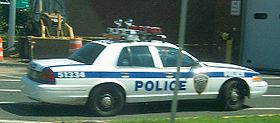

A PAPD Motorcycle Unit RMP parked at the Outerbridge Crossing. The Port Authority Police Department operates a motorcycle unit that consists of a sergeant and 13 police officers. The unit is responsible for patrolling Port Authority tunnels and bridges, with the primary duties of traffic enforcement, truck checks, VIP movements and funeral details. Each member of the unit is assigned his own motorcycle. Before joining the unit, each member must complete the Northwestern University/Harley Davidson Police Officer Training Program.[3]
The original motorcycle unit was disbanded back in 1956 after Police Officer James Calandra was struck and killed while on motorcycle patrol.
Firefighting and Crash Emergency
In June 1998, the Port Authority Police Department opened a state-of-the-art Aircraft Rescue and Firefighting Fuel Spill Trainer Facility at John F. Kennedy International Airport. The facility, one of the largest of its kind in the nation, is used to train Port Authority Police officers in aircraft rescue and firefighting techniques. It allows officers to train for emergency situations in a controlled environment. The centerpiece of the training center is a 125-foot-diameter (38 m) pit that uses clean-burning propane to simulate a fire. It also features a 75-foot (23 m)-long aircraft mockup with a broken wing section. Computer controls allow for the creation of firefighting scenarios that vary in size, difficulty and intensity.[4] Each year, more than 600 Port Authority officers are cross-trained as aircraft rescue firefighters for the region's three major airports - John F. Kennedy International, Newark Liberty International, and LaGuardia airports.[4]
Port Authority Police assigned to aircraft rescue and firefighting undergo rigorous training twice a year to achieve and maintain Federal Aviation Administration certification.[4]
Aviation Unit
After undertaking a study, the PAPD in July 2010 decided to disband its aviation unit, elimination of which will save an estimated $4 million annually in labor, fuel and maintenance costs. In addition, selling the fleet’s two Sikorsky S-76 helicopters is expected to net over $8 million.
During an eight-month review period from August 2008 through April 2009, the choppers made 258 flights, 228 of which were security patrols of Port Authority-operated airports, bridges, tunnels, and other properties. Not a single unusual incident was spotted during these patrols, according to a Wall Street Journal report. One flight was made in response to the US Airways 1549 “Miracle on the Hudson” incident, but the New York City Police Department waved off the PAPD’s assistance. Other flights were made to take aerial photos of facilities. The review also discovered that the Port Authority was the only airport operator in the U.S. to use patrol helicopters.[5]
Training
Recruits typically receive 25 weeks of intensive training at the Port Authority Police Academy, which is located in Jersey City, NJ, with a Regional Training Center located at Kennedy Airport. Training given to recruits includes New York and New Jersey law, behavioral sciences, public relations, police practices and procedures, laws of arrest, court procedures and testimony. They are also trained in rules of evidence, defensive tactics, first aid, fire fighting, police patrol and traffic duty, firearms training, defensive and pursuit driving, water safety and rescue. Throughout their careers, Port Authority Police officers return to the Academy both for refresher courses and for training in new techniques added to the curriculum.
The Koebel Memorial Police Firearms Training Center is dedicated to the memory of Police Officer Henry J. Koebel, who was killed in the line of duty in May 1978. The Police Academy utilizes state-of-the-art equipment where the staff operates eighteen shooting ports within this computerized firearms training facility. Features include moveable target lights and noise controls, shoot/don't shoot situations, as well as standard marksmanship instruction.
Rank structure
There are ten sworn titles (referred to as ranks) in the Port Authority Police Department:
Title Insignia Uniform Shirt Color Deputy Chief White Assistant Chief White Inspector White Captain White Detective Lieutenant
LieutenantWhite Detective Sergeant
SergeantDark Blue Detective
Police OfficerDark Blue Promotion to the ranks of sergeant, lieutenant and captain are made via competitive civil service examinations. Promotion to detective and the higher ranks is at the discretion of the police commissioner.
Power and authority
Port Authority Police officers are classified as police officers in New Jersey and as New York State police officers under paragraph e, subdivision of the state Criminal Procedure Law. With the status of police officer, they are permitted to serve warrants, make arrests, use physical and deadly force, carry and use firearms, carry and use handcuffs, and issue summonses.
Equipment and vehicles
All Port Authority Police officers are equipped with a firearm, expandable baton, can of pepper spray, handcuffs, whistle, flashlight, bullet resistant vest, and a radio that is directly linked to the Central Dispatcher and other Port Authority officers.
Currently, the department utilizes numerous vehicles in its fleet including Ford Crown Victoria Police Interceptors, Chevrolet Impalas, Chevrolet Suburbans, Dodge Chargers, and Harley Davidson motorcycles. The department also utilizes numerous boats.
Salary
A PAPD Police Interceptor parked near the entrance to the World Trade Center construction site.
The PAPD is one of the highest paid police forces in the northeastern United States, thus making it one of the most coveted law enforcement jobs in the region.[citation needed] Under the current contract, the starting salary of police officer is $32,361, and after five years of service, the salary is $90,000,[6] not including promotions or overtime.
With such a high salary, the PAPD has attracted many officers from neighboring departments, most specifically officers from the New York City Police Department.[7]
Line of Duty Deaths
See also: Emergency workers killed in the September 11 attacksSince the establishment of the Port Authority Police Department, 45 officers plus one police K-9 have died in the line-of-duty since 1951. 37 officers died September 11, 2001, including a K-9. 82% of the line-of-duty deaths for the entire history of the department occurred on one terrible day.[8]
Officer's Name End Of Watch Cause Of Death Patrolman Charles Kessler Sunday, December 16, 1951 Accidental Police Officer James Calandra Monday, November 19, 1956 Motorcycle Accident Police Officer Hitler M. Mcleod Friday, November 3, 1961 Gunfire Police Officer Bertram Winkler Tuesday, March 21, 1972 Heart Attack Police Officer Arthur M. Ansert Monday, October 8, 1973 Vehicular Assault Police Officer Henry J. Koebel Friday, May 26, 1978 Gunfire Police Officer William J. Perry Monday, December 22, 1980 Gunfire Police Officer Scott R. Parker Monday, September 5, 1983 Gunfire Police Officer David P. Lemagne Tuesday, September 11, 2001 Terrorist Attack Chief James Romito Tuesday, September 11, 2001 Terrorist Attack Police Officer Richard Rodriguez Tuesday, September 11, 2001 Terrorist Attack Captain Kathy Mazza Tuesday, September 11, 2001 Terrorist Attack Police Officer Liam Callahan Tuesday, September 11, 2001 Terrorist Attack Police Officer James Lynch Tuesday, September 11, 2001 Terrorist Attack Director Of Public Safety Fred V. Morrone Tuesday, September 11, 2001 Terrorist Attack Police Officer James Nelson Tuesday, September 11, 2001 Terrorist Attack Police Officer Uhuru Gonja Houston Tuesday, September 11, 2001 Terrorist Attack Police Officer Clinton Davis Tuesday, September 11, 2001 Terrorist Attack Police Officer Alfonse Niedermeyer Tuesday, September 11, 2001 Terrorist Attack Police Officer Paul Laszczynski Tuesday, September 11, 2001 Terrorist Attack Police Officer Nathaniel Webb Tuesday, September 11, 2001 Terrorist Attack Police Officer John Lennon Tuesday, September 11, 2001 Terrorist Attack Police Officer George Howard Tuesday, September 11, 2001 Terrorist Attack Police Officer Michael Wholey Tuesday, September 11, 2001 Terrorist Attack Inspector Anthony Infante Tuesday, September 11, 2001 Terrorist Attack Lieutenant Robert Cirri Tuesday, September 11, 2001 Terrorist Attack Police Officer Kenneth Tietjen Tuesday, September 11, 2001 Terrorist Attack Police Officer John Levi Tuesday, September 11, 2001 Terrorist Attack Police Officer Thomas Gorman Tuesday, September 11, 2001 Terrorist Attack Police Officer Dominick Pezzulo Tuesday, September 11, 2001 Terrorist Attack Police Officer Antonio Rodrigues Tuesday, September 11, 2001 Terrorist Attack Sergeant Robert Kaulfers Tuesday, September 11, 2001 Terrorist Attack Police Officer Donald McIntyre Tuesday, September 11, 2001 Terrorist Attack Police Officer Donald Foreman Tuesday, September 11, 2001 Terrorist Attack Police Officer Christopher Amoroso Tuesday, September 11, 2001 Terrorist Attack Police Officer Walter McNeil Tuesday, September 11, 2001 Terrorist Attack Police Officer Maurice Barry Tuesday, September 11, 2001 Terrorist Attack Police Officer Joseph Navas Tuesday, September 11, 2001 Terrorist Attack Police Officer James Parham Tuesday, September 11, 2001 Terrorist Attack Police Officer Walwyn Stuart Tuesday, September 11, 2001 Terrorist Attack Police Officer Bruce Reynolds Tuesday, September 11, 2001 Terrorist Attack Police Officer John Skala Tuesday, September 11, 2001 Terrorist Attack Police Officer Gregg Froehner Tuesday, September 11, 2001 Terrorist Attack Police Officer Stephen Huczko Jr. Tuesday, September 11, 2001 Terrorist Attack Police Officer Paul Jurgens Tuesday, September 11, 2001 Terrorist Attack K-9 Sirius Tuesday, September 11, 2001 Terrorist Attack Terrorist attacks
On February 26, 1993 the Port Authority's World Trade Center complex was the target of terrorist attacks. On September 11, 2001, the complex was the target of terrorist attacks for a second time.
The complex housed over 50,000 employees and accommodated 70,000 visitors per day; the efforts of the Port Authority Police, the New York City Police, the New York City Fire Department, New York City EMS, New York State Court Officers, Federal Agents along with countless others helped to minimize the loss of life. The Port Authority Police suffered the worst loss of police personnel in a single event in American history: 37 police officers along with one police K-9 were killed on September 11.
Chart of Port Authority police officers killed on 9/11/01
See also
- List of law enforcement agencies in New Jersey
- List of law enforcement agencies in New York
- Metropolitan Transportation Authority Police
- New Jersey Transit Police Department
- New York City Police Department
- Port Authority of New York and New Jersey
References
- ^ a b PAPD ESU Unit
- ^ PAPD K-9 Unit
- ^ PAPD Motorcycle Unit
- ^ a b c PAPD Firefighting and Crash Emergency Unit
- ^ Molnar, Matt (July 10, 2010). "Port Authority Grounds Its Police Helicopters". NYC Aviation. http://nycaviation.com/2010/07/port-authority-grounds-its-helicopters/.
- ^ PAPD Recruitment - Assignments
- ^ NYPD Officers try to join PAPD
- ^ The Officer Down Memorial Page
External links
- Port Authority of NY/NJ Police
- Port Authority Police Memorial
- Port Authority Police Benevolent Association
- Port Authority Police vehicles
Port Authority of New York and New Jersey Seaports Airports Bridges and tunnels Rail Bus stations Other Police Department · World Trade CenterCategories:- Law enforcement agencies of New York
- Port Authority of New York and New Jersey
- Port of New York and New Jersey
- Transit police departments of the United States
- Airport police departments of the United States
- Specialist police departments of New York
- Port Authority of New York and New Jersey Police Department
- Specialist police departments of New Jersey
- Law enforcement agencies of New York City
- Jersey City, New Jersey
- Port police departments of the United States
Wikimedia Foundation. 2010.

